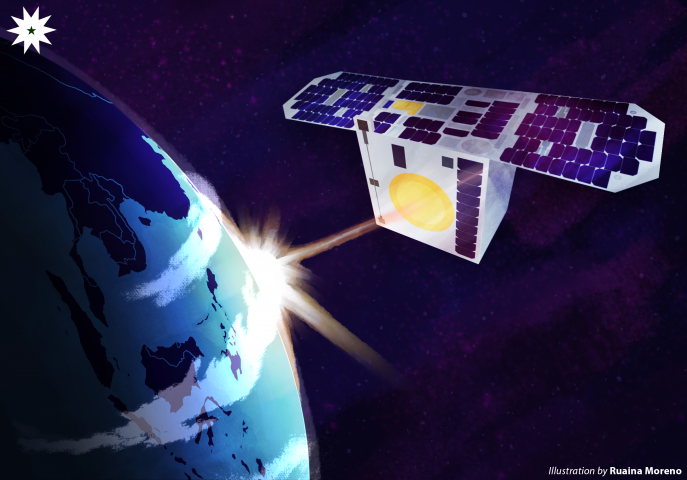Outer space is home to many fascinating things; many have naturally been formed there, like the Moon, and others sent out by mankind, such as artificial satellites. Satellites are defined as objects orbiting around a larger object like a planet, with some of the most popular examples being the International Space Station and Sputnik 1—aiding in conducting space explorations, and providing reception for telecommunication devices like the internet and television sets.
Space technology has also arrived in the Philippines, already developing two microsatellites. Diwata-2, the second Filipino-made microsatellite, was launched from Japan’s Tanegashima Space Center by the Philippine Scientific Earth Observation Microsatellite (PHL-Microsat) Program in October 2018, with the participation of the the Department of Science of Technology (DOST), University of the Philippines Diliman, Hokkaido University, and Tohoku University.
Sustained Support for Local Space Technology & Applications Mastery, Innovation, and Advancement (STAMINA4Space), a DOST-funded PHL-Microsat program, is the main initiative overseeing Diwata-2’s operations. It aims to “continue and build up the research and capacity building activities from the PHL-Microsat Program on satellite development and operations in the country,” as explained by Engr. Ariston Gonzalez, a leading Research and Development Consultant, in an interview with The LaSallian.
Leaps and bounds
A microsatellite refers to a satellite that weighs from 10 to 100 kilograms and has an average lifespan of five to seven years. Categorized as an Earth observation microsatellite, Diwata-2’s serves to collect various information on the changes in the Philippine landscape, in turn enhancing the country’s capacity to assess calamities, communicate during emergencies, and monitor natural and man-made resources.
The newer microsatellite shares some components with its predecessor, Diwata-1. Both feature three scientific instruments: a high-precision telescope for calamity assessment; a space-born multispectral imager (SMI) that filters sensitive portions of light to evaluate the environment being monitored; and field cameras (FCs) for weather forecasting.
However, Diwata-2 is an improvement from its predecessor with the addition of two new instruments—an amateur radio unit to enable emergency communication even with an inconsistent signal, and an enhanced resolution camera to generate sharper images from the data captured by the SMI and FCs.
The newer microsatellite also orbits at a height higher than Diwata-1’s distance from the Earth, giving Diwata-2 a longer lifespan, as the predecessor gave in to material decay due to excessive friction with the planet’s atmosphere.
Following a heliosynchronous orbit—an orbiting pattern in which the microsatellite passes over a portion of the Earth at the same time of day—Diwata-2 takes advantage of its solar panels to keep itself charged, visiting the country every 11 days for monitoring purposes, as well as capturing clearer images thanks to light emitted by the Sun.

Celebrating milestones
“Since its launch to space, it has captured over 3,900 images in total—over 2,290 of which are of the Philippine territory—and has [since] covered 48 percent of the Philippines’ land area,” highlights Engr. Benjamin Magallon, a researcher under STAMINA4Space, explaining that Diwata-2’s imagery capabilities have allowed it to achieve the goals set by PHL-Microsat.
Over its first year in orbit, the microsatellite monitored several typhoons in the Philippines, such as typhoon Hagibis, which brought rain showers and thunderstorms to Visayas and Mindanao last October 2019, and typhoon Tisoy that barrelled through Eastern and Central Visayas, Southern Luzon, and Mindoro last December 2019.
Diwata-2 also witnessed changes in the overall landscape of the country, such as the conversion of Rizal’s provincial areas into a residential community. The rehabilitation of Manila Bay initiated in January of last year, once infamous for its poor water quality, had also not gone unnoticed.
However, these admirable feats were not so easily achieved; the microsatellite’s production phase was particularly challenging, requiring lengthy and robust tests to ensure that it would survive in space for a long time. “Major failure in these tests could mean missing the launch date,” Gonzalez emphasizes. Even with Diwata-2 already in space, it requires a lifetime of optimization processes—minimizing errors and improving its accuracy in pinpointing a region.
The future of local space technology
As of now, PHL-Microsat is attempting to locally manufacture some of the main components used in Diwata-2, as this would help reduce expenses incurred from using parts manufactured abroad. Envisioning the establishment of a competent space technology industry in the country, Magallon elaborates, “We are trying to look and partner with local industries, make them interested and be a part of space technology development.”
Given Diwata-2’s relatively short three-to-five-year lifespan, STAMINA4Space plans to extend Diwata-2’s services to the academic sector through the project Space Science and Technology Proliferation through University Partnerships—establishing an association of universities that will offer courses relevant to space technology.The success of Diwata-2 epitomizes the gradual realization of Philippine space programs. With PHL-Microsat and STAMINA4Space continually developing technologies like Diwata-2 and launching programs to engage the public in space-related advancements, more Filipinos can perhaps become inspired to push Philippine space exploration to greater heights.
